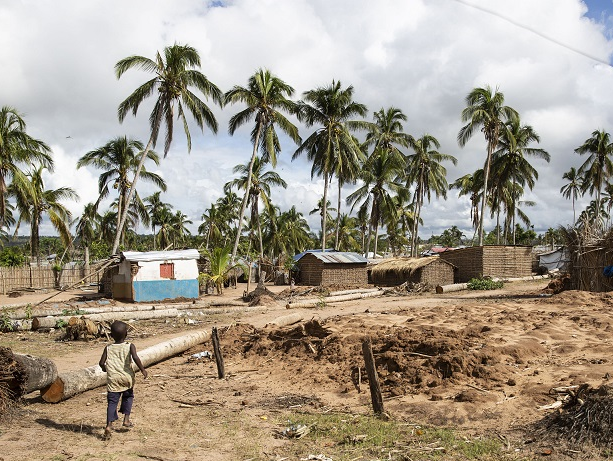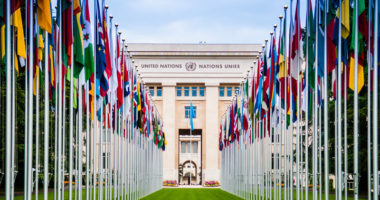Global attention is squarely focused on COP27 of the UN Framework Convention of Climate Change (UNFCCC) now underway in Sharm El Sheikh. Parties to the convention are focusing on defining and operationalizing a Global Goal on Adaptation, the financing of loss and damage, and a new collective quantified goal on climate finance. Attention to people and situations affected by conflict is largely absent in the negotiating space at UNFCCC processes. However, there is increasing awareness in the periphery of climate discussions – notably by humanitarians, peacebuilders and donors whose funded operations cover both traditional humanitarian and climate concerns – of the huge blind spot of climate action in places affected by conflict.
In this post, ICRC Diplomatic Adviser Namita Khatri teases out this blind spot as a result of climate finance mechanisms that are not tailored for conflict situations. Writing from Sharm El Shiekh, she builds upon the ICRC’s work and a recent joint publication written together with Amir Khouzam, Yue Cao and Adriana Quevado on behalf of ICVA, MercyCorps, ODI, the RCRC Climate Centre, UNHCR and WFP to move the conversation towards concrete action with climate policy makers.
It is fascinating talking to policy makers dealing with climate change. Vulnerability means completely different things to a climate change negotiator as it does to a humanitarian working for people affected by conflict. The politics of the negotiations has meant that for climate change negotiators, vulnerability is seen through the lens solely of vulnerability to climate change.
Think of the small island developing States, one of which I come from, where king tides lash coastal communities, saltwater has infiltrated groundwater of farming fields, and where ‘radical transformation’ of entire societies may be the only way to survive. For us at the ICRC, the notion of vulnerability is most brought to life by a mother, widowed by war, with malnourished and ill children she is unable to feed or provide medical care for due to disruption caused by fighting.
Like the multiple ‘tags’ that define me – a humanitarian worker, a mother of two third-culture boisterous kids, a woman from a small island developing State – no single ‘tag’ or situation is ‘more important’ for an individual whose life is upturned by climate change, by conflict, or by a combination of the two. And let’s not forget that these two are not the only faces of this Janus – the pandemic, the global economic downturn, and food insecurity all contribute to already complex causes of vulnerability. That father, that mother, that child – they don’t break down the factors responsible for the difficulties they find themselves in; they just need support to get them back on their feet and adapt to their new reality.
My point is this: each situation needs a contextualized solution. In climate action parlance, this means that finance for adaptation to climate change needs to be designed to address the specific and complex set of vulnerabilities in each context.
No money, more problems
Unfortunately, this is also precisely where the problem lies: international finance in support of climate adaptation is neither contextualized, nor targeted, to help support the adaptive capacity of people living in communities that are highly vulnerable to climate shocks and disrupted by conflict.
Of course, such international finance is available . . . in theory. More than half of the 25 countries most vulnerable to climate change are also affected by conflict, and in 2019, 24 out of 46 Least Developed Countries (LDCs) had active conflicts.[1] As LDCs are prioritized for climate finance under the Paris Agreement, these countries should be receiving contextualized climate finance. Yet, when looking at the cumulative climate finance on a per capita basis between 2010 and 2020 for 43 LDCs, only one conflict-affected LDC received more than the median amount – the majority received a pittance.
It gets further complicated in-country. Countries that do receive climate financing to help people adapt to persistent climate shocks and variations in weather patterns tend to channel the funding to where they feel development gains are the likeliest – and this is rarely in the least stable, violence-affected parts of the country. Take Mozambique, where despite the northern and southern basins facing similar flood risk, the conflict-affected Cabo Delgado region in the north is largely excluded from project design of most internationally funded climate projects.
On the ground, therefore, support to people living through conflict and facing climate shocks is even more grim that national statistics show.
If you position this reality in a global context where each ‘constituency’ or group of countries asking for special attention for their own specific situation, it leads to an impossible scenario for those who need to prioritize where and how to allocate funding.
Embracing discomfort: concrete action to tackle system dynamics
So what is to be done? Well, the problem is clearly systemic. The international aid architecture, and within it the rules for allocating climate finance, are governed by processes and rules that are rigid and not fit-for-purpose. The system is also broken down into silos – humanitarian, development, peace, climate, disaster risk resilience, that make comprehensive and cohesive responses difficult. After all, people do not parse their vulnerabilities and needs into blocks broken down by ‘humanitarian’ or ‘climate’.
Any systemic challenge requires political will to reform that system – in this case, away from the single-sector interventions and expertise that are currently siloed across the international aid structure. This is possible, but it requires stepping out of the status quo of established rules and thinking creatively, with decisions driven not by the paramount consideration of risk management, but by the substance of the needs to build resilience adaptive capacity.
Together with ICVA, ODI, MercyCorps, Red Cross Red Crescent Climate Centre, UNHCR, and WFP, we have recently published a paper ‘Embracing Discomfort: A call to enable finance for climate-change adaptation in conflict settings’. It offers suggestions on concrete action that policy makers can take for a more contextualized and coherent approach to allocate climate finance so it reaches people whose adaptive capacity is the weakest. We are here at COP27 now to share these recommendations with policymakers, as we are concerned with how much is at stake for conflict affected people.
We address four key areas, offering ideas that will need to be tested, adapted, and tweaked with practice. Adopting and implementing these recommendations require stepping well out of the comfort zone, something that policy makers must do, despite the discomfort.
The first area that needs attention is how international financing institutions approach risk. Most funding institutions have stringent processes and rules premised on working in stable, development-oriented contexts. These tend not to work in unstable or conflict affected places. A greater understanding of what it means to operate in such settings can help in creating processes and supporting structures that will work for climate action in such places. Financing institutions can create specialized windows of funding that are reserved for fragile and conflict situations, and which have adapted risk frameworks. A clear policy on how to address climate change and conflict is absent in most financing institutions. This has deterred engagement with actors interested in climate action in such settings. So, a clear step is for governing bodies of financing institutions to put in place conflict and climate change policies to guide their action – and we can help inform the creation of such policies with our knowledge of what it takes to work in conflict.
Second, we know from our experience that working in places enduring conflict often means operating in pockets of populations with specific needs that are not replicated in the rest of the country – what is needed and what works for displaced and host communities on the mainland in Montepuez in Mozambique may be very different to that on Ibo or Quirambo islands. Similarly, as conflict is often localized within a country, large national level adaptation projects are not always fit-for-purpose. We therefore point to the need to ensure that the ambition to scale up adaptation is realized not just through big transformative projects, but also by enabling small scale initiatives that contribute to the resilience of livelihoods and community infrastructure across different time scales. At this scale, local leadership – in design and in implementation – also becomes critical. It is, after all, the local communities who have the greatest knowledge of their lived experience, and it is they who stay and deal with the consequences. They need to be able to access international finance more easily than the current State-centric system allows.
In more unstable places, projects have to be supported in a more dedicated manner by the financing institutions providing the money and monitoring implementation. Adapting the project should the conflict situation change, ensuring that any procurement disruptions are addressed, and responding to local partners are all issues requiring more dedicated support. Financing institutions should be equipped with additional and suitably trained staff to provide required support to a possible plethora of smaller projects. It is a different way of working, and requires a different approach.
The third area that we address implicates ourselves as humanitarian actors. It is easy enough to suggest how national and international financing institutions direct climate finance, but if the problem is indeed systemic, then we have to be a part of the solution. We can’t change the system itself, but we can do two crucial things: one, we can ensure that we don’t contribute to the problem ourselves, and the ICRC has already committed to incorporating climate risk across all its programmes by 2025 as well as examining the climate and environmental impact of its programmes. And two, we as humanitarians must do more to coordinate with partners in the development, disaster and climate sectors. We can establish operational partnerships that optimize our knowledge and experience of operating in conflict settings, with the mandate and expertise of climate adaptation actors with experience on tailoring climate adaptation projects. Look at how we partnered with the Asian Development Bank in Marawi, the Philippines. We conducted an assessment of the infrastructure and capacity of the local water-supply system based on our initial emergency-phase response during hostilities; once hostilities ended, this assessment informed the Asian Development Bank’s decision to invest in the longer-term effort to rehabilitate the entire water system in Marawi – well beyond our capacity and outside our mandate. At a minimum, we must develop active knowledge sharing platforms across sectors to better identify needs in conflict areas that climate and development actors may be able to address.
Our final recommendation is by no means a new one, yet it remains relevant in this niche area of climate adaptation action in places affected by conflict. It is about the silos that exist in national governments coordinating climate action and in national and international financing institutions that have fragility and conflict teams that don’t interact with their climate teams. We know that in many places, the same donor has different operations in a country – with fragility and conflict teams funding ‘humanitarian’ responses in places affected by conflict, while their climate teams fund climate action in more stable parts. Similarly, in the governments of recipient States, different agencies are mandated to lead with different donors. Typically, a Ministry of Finance will liaise with the multilateral development banks, the Ministry of Foreign Affairs with bilateral donors, an Environment Ministry with the Global Environment Facility, the Agriculture Ministry with FAO and WFP, and more recently created climate change units with the Green Climate Fund. This can result in multiple projects that are not coherent or coordinated, both at the donor end and the recipient end. In stable settings, where governments have wide reach across their territory, this is being addressed. However, in places affected by conflict, neither donors nor central authorities tend to have clear assessments of the needs in the pockets affected by conflict.
We hope that by raising these issues, we invigorate discussion towards solutions. We do not have all the answers, but we know that we need to move beyond identification towards action. We need to test these recommendations. After all, the greatest risk lies in the failure to make the attempt.
[1] Para 89, The Doha Programme of Action for LDCs 2022-2031, Resolution 76/258, UNGA.
See also:
- Sarah Gale, Climate and environment considerations for weapon bearers in armed conflict, September 22, 2022
- Catherine-Lune Grayson, A plea for COP26: don’t forget people affected by conflict, October 27, 2021
- Janani Vivekananda, Climate, conflict and crises: first and foremost, do no harm, February 27, 2020
- Catherine-Lune Grayson, When rain turns to dust: climate change, conflict and humanitarian action, December 5, 2019






Comments